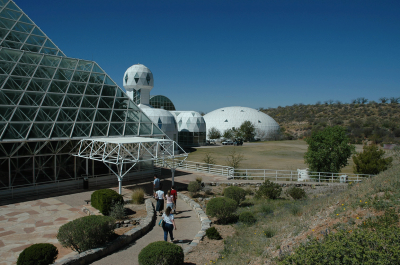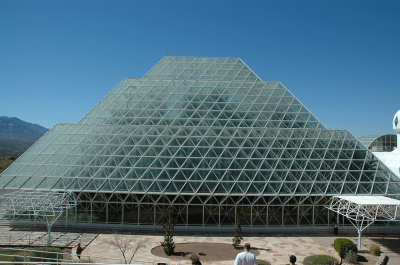
Biosphere2
Secession, Vienna, 2005
On Mobility at De Appel, BüroFriedrich Berlijn, CAC Vilnius, 2006
Domain of the Great Bear, Dystopische Landschaft, Kunstraum München, Munich, 2006
Biosphere2

Biosphere 2 is an artificial, closed ecological system in Oracle, Arizona, built by Texas billionaire Edward Bass, Space Biosphere Ventures and others. Biosphere 2 is modelled on Biosphere 1: Earth. Constructed in the late eighties, this experimental world was used to test and study if and how people could live in a closed biosphere. This hermetically sealed New Age Garden of Eden offers a glance into the future, a taste of what life might be like in a space colony.
The physical structure of Biosphere 2 is made of steel tubing and frames and high-performance glass, designed by a firm run by a former student of Buckminster Fuller, Peter Pearce. It was described as planet in a bottle and houses over 3800 species of plants and animals in five distinct ecological biomes: a marsh, a desert, a savannah, an ocean, and a rainforest. The indoor rain and tides are controlled by computer from the Biosphere Command Room. Over 1000 sensors distributed throughout the Biosphere send information to the control system Mission Control. This computer network provides a continuous display of environmental variables and the status of engineering controls while constantly updating the permanent database.
The eight testpersons who entered Biosphere 2 in 1991 and 1994 wore futuristic jump suits made by one of Marilyn Monroe's cloth designers.
On one-half acre of land, they have grown their food. As a social experiment it was -unintentionally- a precursor to Big Brother. The project was aborted prematurely due to various difficulties with the ecological system and tensions between the testpersons. Today, Biosphere 2 is a touristic site.
The experiment showed how difficult it is to copy the functions of the natural capital of earth. Despite huge expenditure, the attempt to make a new biosphere did not sustain eight humans for a limited time. Some economists have used the price of the Biosphere 2 to calculate the total value of earth. This leads to a large, but finite, price of earth itself.
Biosphere 2 and Trinity site are each others counterparts, though they bear similarities: both tourist sites, both boosted by a vision about the future, both experimental dealing with the concept of a world that may or may not become unliveable. Where Biosphere 2 failed to construct a self-sustaining closed environment, the success of Trinity and the further developments following the first experiment (testing the first atom bomb), are, at the very least, ambiguous.
Biosphere2 consists of series of 15 inkjetprints and texts that describes the daily menu
